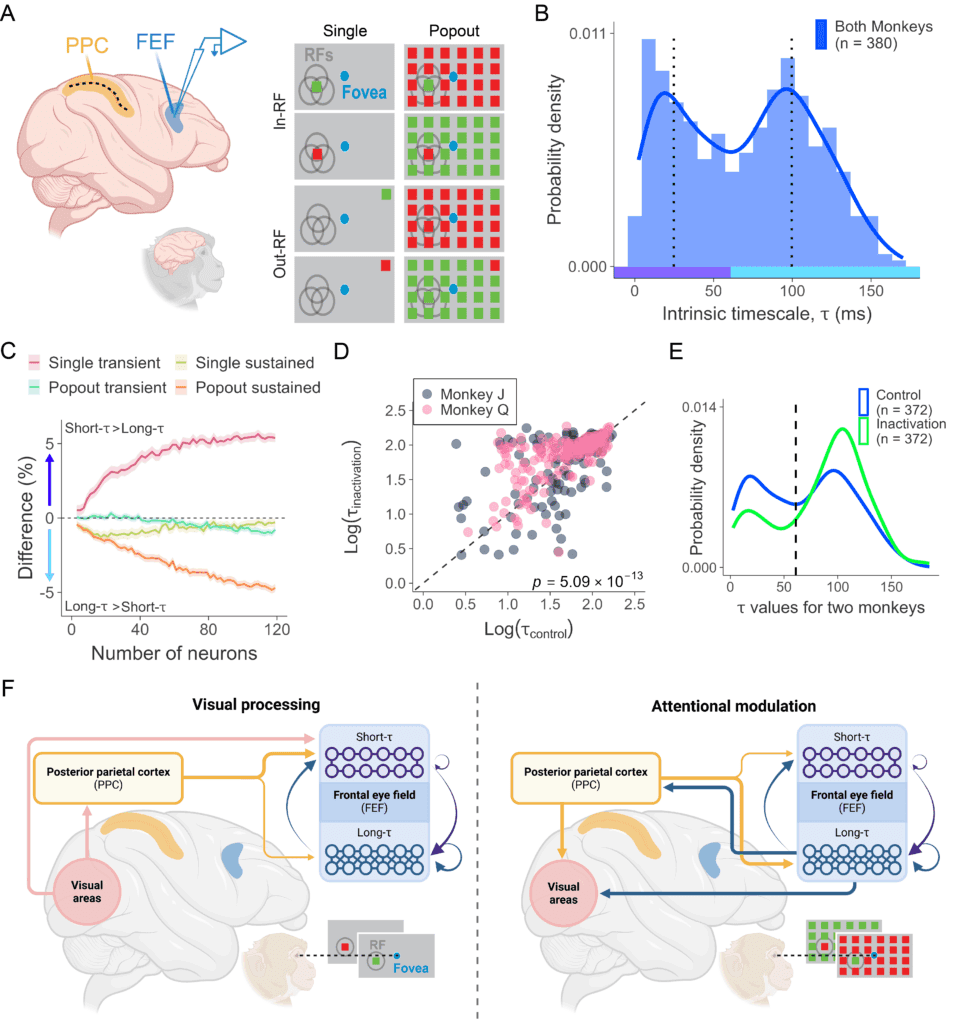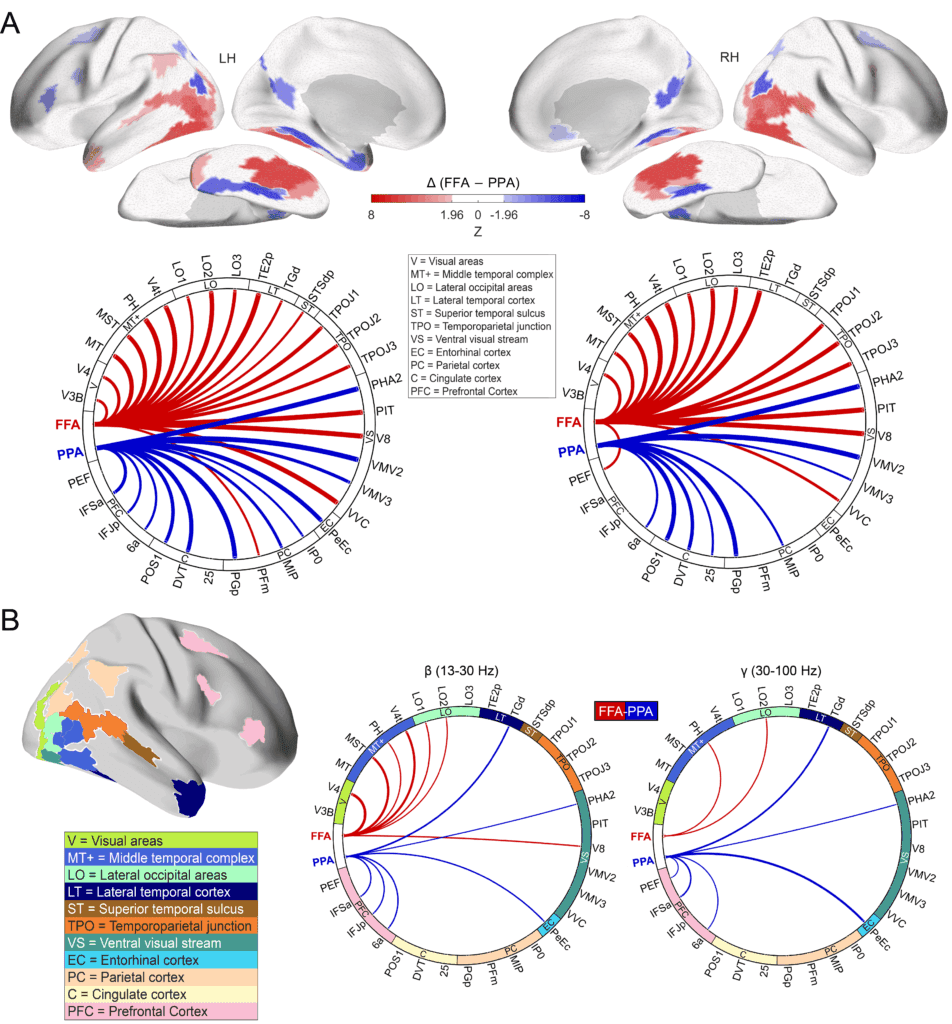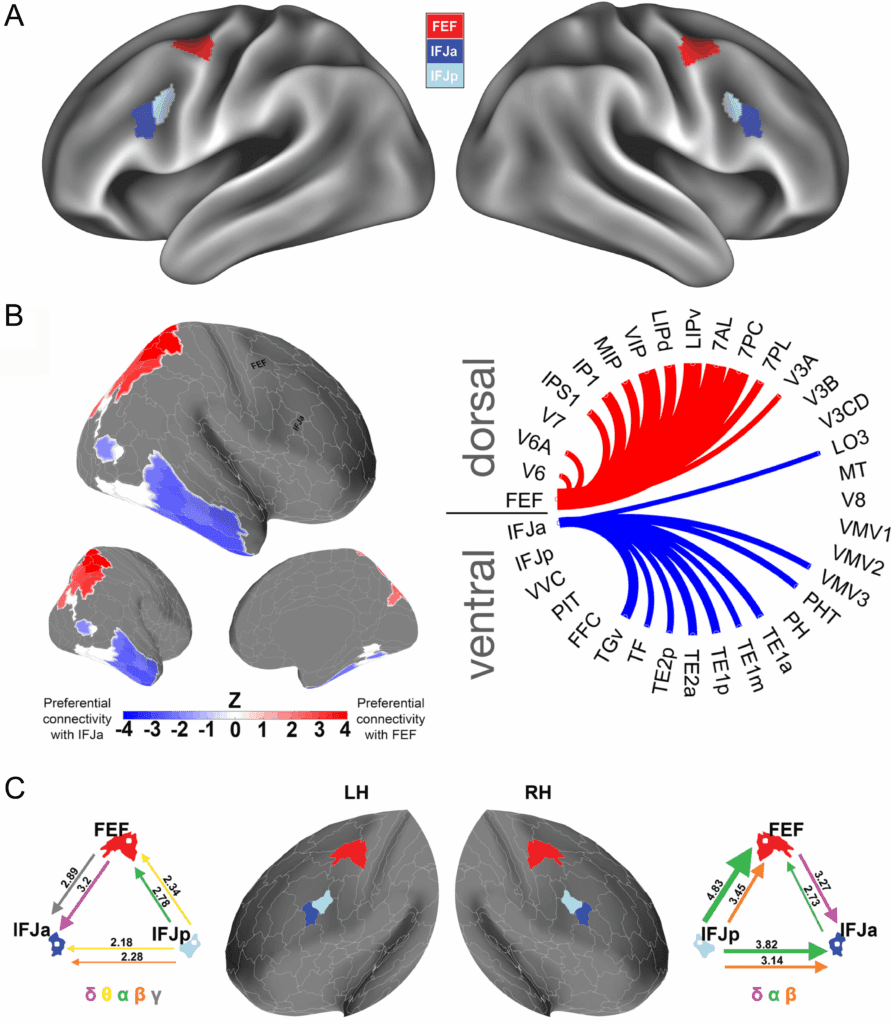
def research():
"""
1-Selective control of prefrontal neural timescales by parietal cortex
 Intrinsic neural timescales reflect the persistence of spontaneous activity and are shaped by local and long-range circuit interactions; however, a causal link between inter-area communication and local timescales has not been established. This study investigates the diversity of intrinsic timescales in the primate frontal eye field (FEF) and provides the first causal evidence for their regulation by inputs from the posterior parietal cortex (PPC). We recorded single-unit activity in the FEF of rhesus macaques while reversibly inactivating the PPC using cryoloops. Our analysis of baseline activity revealed a bimodal distribution of intrinsic timescales, identifying two functionally distinct classes of FEF neurons: a short-timescale (short-τ, ~27 ms) population and a long-timescale (long-τ, ~103 ms) population. These classes were functionally specialized: short-τ neurons exhibited stronger transient visual responses, while long-τ neurons showed more pronounced sustained attentional modulation to salient popout stimuli. Critically, PPC inactivation selectively altered both the dynamics and function of these populations. Inactivation significantly increased intrinsic timescales, with a disproportionately larger effect on short-τ neurons. Concurrently, it reduced salience representation, an effect most prominent in long-τ neurons during the sustained response period. These findings demonstrate that long-range inputs from the PPC selectively control intrinsic dynamics and functional computations within the FEF.
Intrinsic neural timescales reflect the persistence of spontaneous activity and are shaped by local and long-range circuit interactions; however, a causal link between inter-area communication and local timescales has not been established. This study investigates the diversity of intrinsic timescales in the primate frontal eye field (FEF) and provides the first causal evidence for their regulation by inputs from the posterior parietal cortex (PPC). We recorded single-unit activity in the FEF of rhesus macaques while reversibly inactivating the PPC using cryoloops. Our analysis of baseline activity revealed a bimodal distribution of intrinsic timescales, identifying two functionally distinct classes of FEF neurons: a short-timescale (short-τ, ~27 ms) population and a long-timescale (long-τ, ~103 ms) population. These classes were functionally specialized: short-τ neurons exhibited stronger transient visual responses, while long-τ neurons showed more pronounced sustained attentional modulation to salient popout stimuli. Critically, PPC inactivation selectively altered both the dynamics and function of these populations. Inactivation significantly increased intrinsic timescales, with a disproportionately larger effect on short-τ neurons. Concurrently, it reduced salience representation, an effect most prominent in long-τ neurons during the sustained response period. These findings demonstrate that long-range inputs from the PPC selectively control intrinsic dynamics and functional computations within the FEF.
Soyuhos, O., Zirnsak, M., Moore, T., Chaudhuri, R., & Chen, X. (2025). Selective control of prefrontal neural timescales by parietal cortex. BioRxiv, 2025-01. https://doi.org/10.1101/2024.09.30.615928.
2-Intrinsic connectomes of the FFA and PPA predict domain-specific perceptual performance
 Face and scene perception are supported by specialized neural systems centered on the Fusiform Face Area (FFA) and Parahippocampal Place Area (PPA), respectively. This study aimed to characterize the broader intrinsic networks anchored by these regions and determine if their connectivity architecture is behaviorally relevant. Using a multimodal approach with resting-state fMRI and MEG data, we mapped the spatio-temporal connectivity profiles of the FFA and PPA. The fMRI analyses revealed spatially segregated networks: the FFA demonstrated preferential connectivity with lateral occipitotemporal, inferior temporal, and temporoparietal regions, while the PPA connected more strongly with ventral medial visual, posterior cingulate, and entorhinal-perirhinal areas. MEG analyses showed this segregation was primarily reflected in beta and gamma band amplitude coupling. Crucially, using connectome-based predictive modeling (CPM), we established a functional double dissociation: the strength of connectivity within the FFA-anchored network significantly predicted individual reaction times on a face-matching task, but not a scene task. Conversely, connectivity within the PPA-network predicted performance on 0-back and 2-back scene tasks, but not the face task. These findings demonstrate that the FFA and PPA anchor distinct intrinsic networks whose underlying functional architecture is a significant predictor of individual differences in domain-specific perceptual abilities.
Face and scene perception are supported by specialized neural systems centered on the Fusiform Face Area (FFA) and Parahippocampal Place Area (PPA), respectively. This study aimed to characterize the broader intrinsic networks anchored by these regions and determine if their connectivity architecture is behaviorally relevant. Using a multimodal approach with resting-state fMRI and MEG data, we mapped the spatio-temporal connectivity profiles of the FFA and PPA. The fMRI analyses revealed spatially segregated networks: the FFA demonstrated preferential connectivity with lateral occipitotemporal, inferior temporal, and temporoparietal regions, while the PPA connected more strongly with ventral medial visual, posterior cingulate, and entorhinal-perirhinal areas. MEG analyses showed this segregation was primarily reflected in beta and gamma band amplitude coupling. Crucially, using connectome-based predictive modeling (CPM), we established a functional double dissociation: the strength of connectivity within the FFA-anchored network significantly predicted individual reaction times on a face-matching task, but not a scene task. Conversely, connectivity within the PPA-network predicted performance on 0-back and 2-back scene tasks, but not the face task. These findings demonstrate that the FFA and PPA anchor distinct intrinsic networks whose underlying functional architecture is a significant predictor of individual differences in domain-specific perceptual abilities.
Soyuhos, O., Scarpa, A., & Baldauf, D. (2025). Distinct resting-state connectomes for face and scene perception predict individual task performance. BioRxiv, 2025-07. https://doi.org/10.1101/2025.07.09.663812.
3-Dissociable functional connectivity fingerprints of the frontal eye field and inferior frontal junction
 In this project, we investigated whether the functional segregation of the frontal eye field (FEF) for spatial processing and the inferior frontal junction (IFJ) for nonspatial processing is reflected in their intrinsic functional connectivity patterns. We applied seed-based functional connectivity analyses to resting-state magnetoencephalography (MEG) recordings, parcellating the brain with the multimodal Glasser atlas. We found that the FEF has a robust power correlation with the dorsal visual pathway, particularly in the beta and gamma bands. In contrast, the anterior IFJ (IFJa) shows strong power coupling with the ventral visual stream in delta, beta, and gamma oscillations. Phase-based metrics further supported this dissociation, with the FEF phase-coupled to the superior parietal lobe in the beta band and the IFJa phase-coupled to the temporal cortex in delta and gamma bands. We conclude that the FEF and IFJ have distinct, frequency-specific intrinsic connectivity fingerprints that are congruent with their respective functional roles in spatial versus nonspatial top-down attention and working memory control.
In this project, we investigated whether the functional segregation of the frontal eye field (FEF) for spatial processing and the inferior frontal junction (IFJ) for nonspatial processing is reflected in their intrinsic functional connectivity patterns. We applied seed-based functional connectivity analyses to resting-state magnetoencephalography (MEG) recordings, parcellating the brain with the multimodal Glasser atlas. We found that the FEF has a robust power correlation with the dorsal visual pathway, particularly in the beta and gamma bands. In contrast, the anterior IFJ (IFJa) shows strong power coupling with the ventral visual stream in delta, beta, and gamma oscillations. Phase-based metrics further supported this dissociation, with the FEF phase-coupled to the superior parietal lobe in the beta band and the IFJa phase-coupled to the temporal cortex in delta and gamma bands. We conclude that the FEF and IFJ have distinct, frequency-specific intrinsic connectivity fingerprints that are congruent with their respective functional roles in spatial versus nonspatial top-down attention and working memory control.
Soyuhos, O., & Baldauf, D. (2023). Functional connectivity fingerprints of the frontal eye field and inferior frontal junction suggest spatial versus nonspatial processing in the prefrontal cortex. The European journal of neuroscience, 57(7), 1114–1140. https://doi.org/10.1111/ejn.15936.